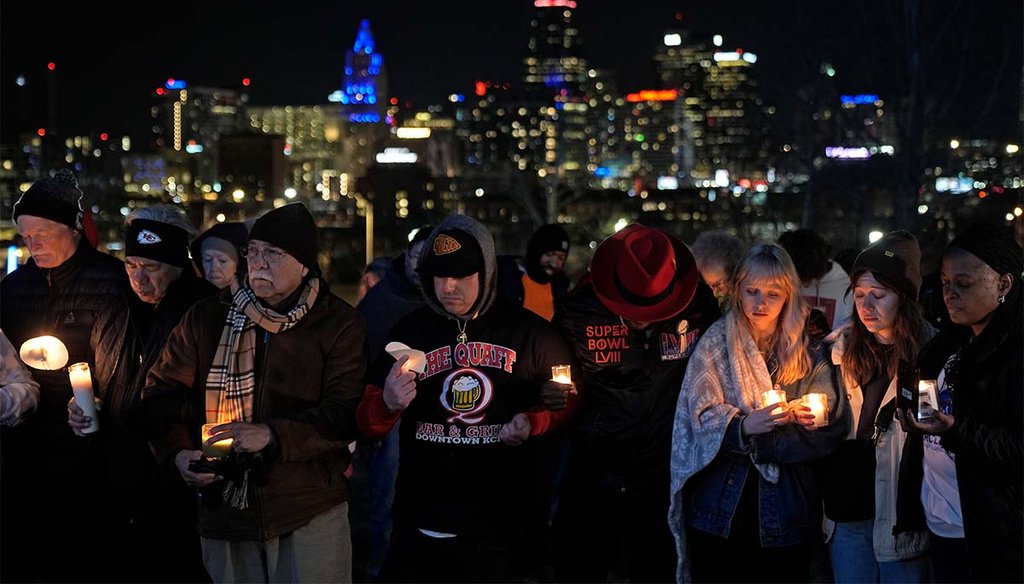Stand up for the facts!
Our only agenda is to publish the truth so you can be an informed participant in democracy.
We need your help.
I would like to contribute

People attend a candlelight vigil Feb. 15, 2024, in Kansas City, Mo., for victims of the Feb. 14, 2024, shooting at a Kansas City Chiefs’ Super Bowl victory rally. (AP)
If Your Time is short
-
There is no legal definition of “mass shooting.” Organizations that collect this data use their own definitions.
-
The Gun Violence Archive defines mass shootings as incidents in which at least four people are injured or killed, excluding the shooter. Other databases use a narrower definition that includes at least four deaths.
-
Our mission: Help you be an informed participant in democracy. Learn more.
After a mass shooting in Kansas City, Missouri, left one woman dead and more than 20 people injured, President Joe Biden said "gun violence "is ripping apart" families and American communities daily.
On Valentine’s Day, the sixth anniversary of the Marjory Stoneman Douglas High School shooting in Parkland, Florida, Biden reeled off a list of other shootings in the headlines, including three police officers wounded in Washington, D.C., and four students wounded at a high school in Atlanta.
"We’ve now had more mass shootings in 2024 than there have been days in the year," he said.
Feb. 14 was 2024’s 45th day. The Gun Violence Archive, a frequently cited source, showed 49 mass shootings as of Feb. 15.
We fact-checked similar comparisons in 2022 after the Uvalde, Texas, elementary school massacre and in 2023 after a mass shooting at Michigan State University.
Sign up for PolitiFact texts
This common talking point is rooted in an American reality. But it isn’t as precise as it sounds.
One issue, from a fact-checker’s perspective, is the lack of a universal definition for a "mass shooting." Politicians often cite reliable sources for this claim, but the organizations that track mass shootings use different criteria.
Mass shootings are a small slice of gun deaths overall, which includes homicides and suicides.
"The public should view these incidents as one piece of the gun violence puzzle, not the only piece," said Jaclyn Schildkraut, executive director of the Regional Gun Violence Research Consortium at the Rockefeller Institute of Government.
Different groups measure mass shootings based on the number of people shot, injured or killed. Some groups exclude gang violence or domestic violence, keeping the focus on events when a shooter fired a gun at random in public.
-
The Gun Violence Archive, a data collection and research group, defines mass shootings as incidents in which at least four people are injured or killed, excluding the shooter. The archive counts 49 mass shootings in 2024, backing up Biden’s math.
-
USA Today, The Associated Press and Northeastern University’s mass killings database tracks incidents in which four or more people, excluding the offender, were killed within a 24-hour time frame. (This database tracks incidents where the offender used a firearm or other weapons.) There have been seven mass killings so far in 2024.
-
Mother Jones’ open-source database tracks shootings with at least three victims killed, while excluding shootings from some "conventionally motivated crimes," such as armed robbery or gang violence. This database was last updated Dec. 6, 2023. There have been no mass shootings in 2024 that meet the Mother Jones database’s definition.
The federal government uses different thresholds, too. After the 2012 shooting at Sandy Hook Elementary School in Newtown, Connecticut, an act of Congress defined "mass killings" as three or more killings in one incident.
But the FBI since 2013 has defined a mass shooting as four or more deaths, the nonpartisan Congressional Research Service mirrored the FBI’s metric in 2015.
This means the Feb. 14 Kansas City shooting, which killed one person and injured 22 people, is counted in the Gun Violence Archive, but not in all datasets.
Whatever the definition, the number of mass shootings has generally been increasing.
The Gun Violence Archive found 656 mass shootings in 2023, fewer than 2021, but up from 272 in 2014. The USA Today, AP and Northeastern University database found 2023 had the most mass shootings (39) and the most public mass shootings (10) since it began tracking in 2006.
Gun violence experts generally agree that citing any database requires context about the definitions.
James Alan Fox, a Northeastern University criminologist, said the Gun Violence Archive data has value, but it’s hard to compare the shooting in Kansas City, when one person was killed while many others were injured, to Uvalde, where 20 people, mostly children, were killed.
When people hear 49 mass shootings, Fox said, "they think these things like Uvalde and school shootings (are) happening every day. They are not."
Two well-known advocacy groups — the Giffords Law Center to Prevent Gun Violence and Everytown for Gun Safety — cite the Gun Violence Archive.
"We choose to use this definition because we believe it more fully captures the broader burden of mass shootings in the U.S., including the burden of nonfatal injuries," said Kelly Drane, the law center’s research director. (The law center is led by former U.S. Rep. Gabrielle Giffords, D-Ariz., who was injured in a mass shooting in a supermarket parking lot in 2018 that left six people dead.)
Drane said that a mass shooting definition of four or more people killed would exclude the Michigan State University shooting that killed three people and wounded five more.
"The impact of this shooting on the victims and the broader MSU and Michigan community was and is significant," Drane said.
Schildkraut said the archive’s broad count does not account for context, putting mass public shootings in the same category as shootings among gangs or family members.
"In reality, however, these contextual differences have important implications for how we prevent and respond to these incidents," Schildkraut said.
Mass public shootings are often premeditated, which creates a longer window for prevention than a spontaneous fight. Policies such as "red flag" laws, which allow courts to remove guns from people who could pose a threat to themselves or others, are helpful prevention tools for premeditated shootings but not for spontaneous ones, Schildkraut said.
Gun violence researchers point out that mass shootings generate significant public attention even though they comprise a fraction of gun-related deaths.
In 2021, about 3% of gun homicides were from mass shootings with at least four people shot. Using the more narrow definition of mass killings involving four or more people killed, that drops to slightly less than 1%, Fox said.
Preliminary data shows that gun deaths, excluding suicides, declined for a second straight year in 2023. The Trace, a news website that covers gun violence, wrote that nearly 3 in 4 U.S. cities experienced a year-to-date drop in homicides, citing data from 175 cities.
Schildkraut is waiting on final data from the Centers for Disease Control and Prevention and additional research about what contributed to the change.
Suicide has long accounted for the majority of U.S. gun deaths, according to April 2023 research by the Pew Research Center, a nonpartisan source of analysis.
Polls show a significant percentage of people say they avoid attending certain events due to fears of gun violence or have considered avoiding such events.
"They are a particularly visible manifestation of a very large problem," said Garen Wintemute, director of the University of California, Davis’ Violence Prevention Research Program. "They are uniquely capable of mobilizing public opinion in support of evidence-based measures that would have broad beneficial effects."
Mass shootings in Uvalde and Buffalo, New York, led Congress, under Democratic control, to pass the first gun control action in decades, Bipartisan Safer Communities Act.
"If that hadn’t happened, would the bill have passed or been as much of a priority?" Schildkraut said. "Hard to say, but the occurrence of Uvalde certainly did facilitate the interest in getting it across the finish line."
RELATED: Ask PolitiFact: What does the data show on deadly shootings by 18-to-20-year-olds?
RELATED: The US homicide rate has declined, but Democrat Sen. Chris Murphy overstates effect of gun law
RELATED: Poll data backs Kamala Harris’ claim that 1 in 5 Americans have lost a family member to gun violence
Our Sources
Gun Violence Archive, Mass Shooting Methodology and Reasoning, accessed Feb. 14, 2024
USA Today, Mass killing database: Revealing trends, details and anguish of every US event since 2006, Feb. 15, 2024
Mother Jones, A guide to mass shootings in America, Dec. 6, 2023
Everytown for Gun Safety, Mass shootings in America, March, 2023
Congressional Research Service, Mass Murder with Firearms: Incidents and Victims, 1999-2013, July 30, 2015
Congress, ‘Investigative Assistance for Violent Crimes Act of 2012, Jan. 14, 2013
Pew Research Center, What the data says about gun deaths in the U.S. April 2023
The Trace, Gun violence by the numbers in 2023, Dec. 31, 2023
TIME, A Third of Americans Avoid Certain Places Because They Fear Mass Shootings, Aug. 15, 2019
Gallup, Nearly Half in U.S. Fear Being the Victim of a Mass Shooting, Sept. 10, 2019
PolitiFact, What counts as a "mass shooting"? The definition varies, Feb. 14, 2023
PolitiFact, Congress passes historic bipartisan gun legislation: Bipartisan Safer Communities Act, June 24, 2022
Email interview, Olivia Dalton, White House spokesperson, Feb. 15, 2024
Email interview, Jaclyn Schildkraut, executive director, Regional Gun Violence Research Consortium at the Rockefeller Institute of Government, Feb. 15, 2024
Email interview, James Alan Fox, professor of Criminology, Law & Public Policy at Northeastern University, Feb. 15, 2024
Email interview, Kelly Drane, research director at the Giffords Law Center to Prevent Gun Violence, Feb. 15, 2024
Email interview, Garen Wintemute, director of the Violence Prevention Research Program at UC Davis, Feb. 15, 2024
















































